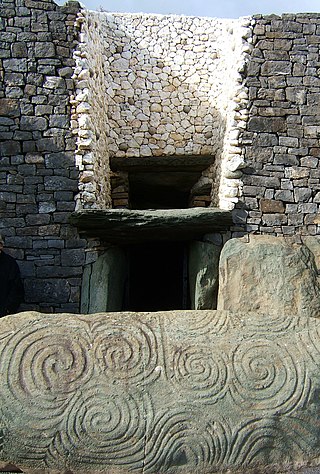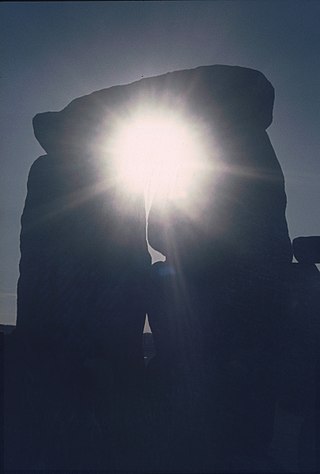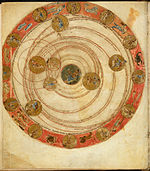
Archaeoastronomy is the interdisciplinary or multidisciplinary study of how people in the past "have understood the phenomena in the sky, how they used these phenomena and what role the sky played in their cultures". Clive Ruggles argues it is misleading to consider archaeoastronomy to be the study of ancient astronomy, as modern astronomy is a scientific discipline, while archaeoastronomy considers symbolically rich cultural interpretations of phenomena in the sky by other cultures. It is often twinned with ethnoastronomy, the anthropological study of skywatching in contemporary societies. Archaeoastronomy is also closely associated with historical astronomy, the use of historical records of heavenly events to answer astronomical problems and the history of astronomy, which uses written records to evaluate past astronomical practice.

The ecliptic or ecliptic plane is the orbital plane of Earth around the Sun. From the perspective of an observer on Earth, the Sun's movement around the celestial sphere over the course of a year traces out a path along the ecliptic against the background of stars. The ecliptic is an important reference plane and is the basis of the ecliptic coordinate system.

Astronomy is the oldest of the natural sciences, dating back to antiquity, with its origins in the religious, mythological, cosmological, calendrical, and astrological beliefs and practices of prehistory: vestiges of these are still found in astrology, a discipline long interwoven with public and governmental astronomy. It was not completely separated in Europe during the Copernican Revolution starting in 1543. In some cultures, astronomical data was used for astrological prognostication.

The zodiac is a belt-shaped region of the sky that extends approximately 8° north and south of the ecliptic, the apparent path of the Sun across the celestial sphere over the course of the year. Also within this zodiac belt appear the Moon and the brightest planets, along their orbital planes. The zodiac is divided along the ecliptic into 12 equal parts ("signs"), each occupying 30° of celestial longitude. These signs roughly correspond to the astronomical constellations with the following modern names: Aries, Taurus, Gemini, Cancer, Leo, Virgo, Libra, Scorpio, Sagittarius, Capricorn, Aquarius, and Pisces.

The equatorial coordinate system is a celestial coordinate system widely used to specify the positions of celestial objects. It may be implemented in spherical or rectangular coordinates, both defined by an origin at the centre of Earth, a fundamental plane consisting of the projection of Earth's equator onto the celestial sphere, a primary direction towards the March equinox, and a right-handed convention.

In astronomy, the ecliptic coordinate system is a celestial coordinate system commonly used for representing the apparent positions, orbits, and pole orientations of Solar System objects. Because most planets and many small Solar System bodies have orbits with only slight inclinations to the ecliptic, using it as the fundamental plane is convenient. The system's origin can be the center of either the Sun or Earth, its primary direction is towards the March equinox, and it has a right-hand convention. It may be implemented in spherical or rectangular coordinates.

Sidereal time is a system of timekeeping used especially by astronomers. Using sidereal time and the celestial coordinate system, it is easy to locate the positions of celestial objects in the night sky. Sidereal time is a "time scale that is based on Earth's rate of rotation measured relative to the fixed stars".

In astronomy, axial precession is a gravity-induced, slow, and continuous change in the orientation of an astronomical body's rotational axis. In the absence of precession, the astronomical body's orbit would show axial parallelism. In particular, axial precession can refer to the gradual shift in the orientation of Earth's axis of rotation in a cycle of approximately 26,000 years. This is similar to the precession of a spinning top, with the axis tracing out a pair of cones joined at their apices. The term "precession" typically refers only to this largest part of the motion; other changes in the alignment of Earth's axis—nutation and polar motion—are much smaller in magnitude.
The heliacal rising of a star or a planet occurs annually when it first becomes visible above the eastern horizon at dawn just before sunrise after a complete orbit of the Earth around the Sun. Historically, the most important such rising is that of Sirius, which was an important feature of the Egyptian calendar and astronomical development. The rising of the Pleiades heralded the start of the Ancient Greek sailing season, using celestial navigation, as well as the farming season. Heliacal rising is one of several types of risings and settings, mostly they are grouped into morning and evening risings and settings of objects in the sky. Culmination in the evening and then morning is set apart by half a year, while on the other hand risings and settings in the evenings and the mornings are only at the equator set apart by half a year.

Sir Joseph Norman Lockyer was an English scientist and astronomer. Along with the French scientist Pierre Janssen, he is credited with discovering the gas helium. Lockyer also is remembered for being the founder and first editor of the influential journal Nature.

Spherical astronomy, or positional astronomy, is a branch of observational astronomy used to locate astronomical objects on the celestial sphere, as seen at a particular date, time, and location on Earth. It relies on the mathematical methods of spherical trigonometry and the measurements of astrometry.

The prehistoric monument of Stonehenge has long been studied for its possible connections with ancient astronomy. The site is aligned in the direction of the sunrise of the summer solstice and the sunset of the winter solstice.

The following outline is provided as an overview of and topical guide to astronomy:

A lunar standstill or lunistice is when the Moon reaches its furthest north or furthest south point during the course of a month. The declination at lunar standstill varies in a cycle 18.6 years long between 18.134° and 28.725°, due to lunar precession. These extremes are called the minor and major lunar standstills.

Babylonian astronomy was the study or recording of celestial objects during the early history of Mesopotamia. The numeral system used, sexagesimal, was based on sixty, as opposed to ten in the modern decimal system. This system simplified the calculating and recording of unusually great and small numbers.
The Astronomical Almanac is an almanac published by the United Kingdom Hydrographic Office; it also includes data supplied by many scientists from around the world. On page vii, the listed major contributors to its various Sections are: H.M Nautical Almanac Office, United Kingdom Hydrographic Office; the Nautical Almanac Office, United States Naval Observatory; the Jet Propulsion Laboratory, California Institute of Technology; the IAU Standards Of Fundamental Astronomy (SOFA) initiative; the Institut de Mécanique Céleste et des Calcul des Éphémerides, Paris Observatory; and the Minor Planet Center, Cambridge, Massachusetts. It is considered a worldwide resource for fundamental astronomical data, often being the first publication to incorporate new International Astronomical Union resolutions. The almanac largely contains Solar System ephemerides based on the JPL Solar System integration "DE440", and catalogs of selected stellar and extragalactic objects. The material appears in sections, each section addressing a specific astronomical category. The book also includes references to the material, explanations, and examples. It used to be available up to one year in advance of its date, however the current 2024 edition became available only one month in advance; in December 2023.

Egyptian astronomy started in prehistoric times, in the Predynastic Period. In the 5th millennium BCE, the stone circles at Nabta Playa may have made use of astronomical alignments. By the time the historical Dynastic Period began in the 3rd millennium BCE, the 365 day period of the Egyptian calendar was already in use, and the observation of stars was important in determining the annual flooding of the Nile.
In astronomy, Jyotirmimamsa is a treatise on the methodology of astronomical studies authored by Nilakantha Somayaji (1444–1544) in around 1504 CE. Nilakantha somayaji was an important astronomer-mathematician of the Kerala school of astronomy and mathematics and was the author of the much celebrated astronomical work titled Tantrasamgraha. This book stresses the necessity and importance of astronomical observations to obtain correct parameters for computations and to develop more and more accurate theories. It even discounts the role of revealed wisdom and divine intuitions in studying astronomical phenomena. Jyotirmimamsa is sometimes cited as proof to establish that modern methodologies of scientific investigations were known to ancient and medieval Indians. Neelkantha Somayaji insisted that computational results should tally with that of observations and astronomical parameters and constants should be revised periodically. To come to more precise conclusions, Neelkantha Somayaji have discussions with the astronomer and mathematicians of other schools.
This glossary of astronomy is a list of definitions of terms and concepts relevant to astronomy and cosmology, their sub-disciplines, and related fields. Astronomy is concerned with the study of celestial objects and phenomena that originate outside the atmosphere of Earth. The field of astronomy features an extensive vocabulary and a significant amount of jargon.
Maya astronomy is the study of the Moon, planets, Milky Way, Sun, and astronomical phenomena by the Precolumbian Maya Civilization of Mesoamerica. The Classic Maya in particular developed some of the most accurate pre-telescope astronomy in the world, aided by their fully developed writing system and their positional numeral system, both of which are fully indigenous to Mesoamerica. The Classic Maya understood many astronomical phenomena: for example, their estimate of the length of the synodic month was more accurate than Ptolemy's, and their calculation of the length of the tropical solar year was more accurate than that of the Spanish when the latter first arrived. Many temples from the Maya architecture have features oriented to celestial events.

















